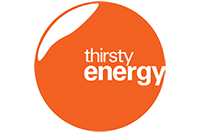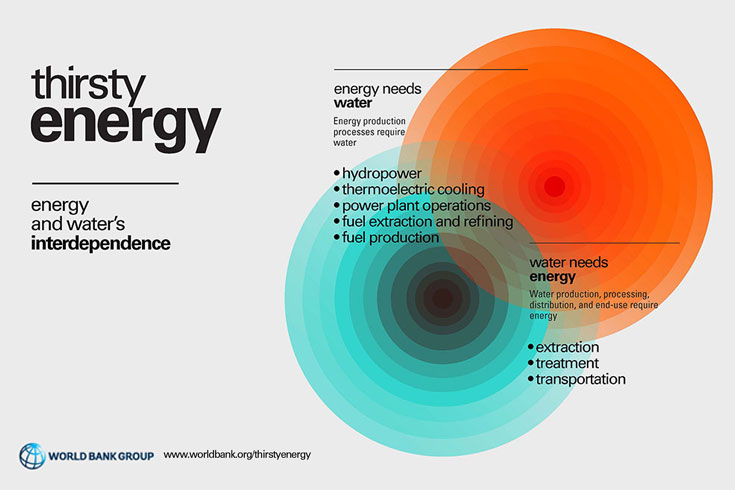EXPLORE: CASE STUDIES | PUBLICATIONS | BLOGS | INFOGRAPHICS
The Water-Energy Challenge
Water and energy are interlinked. Significant amounts of water are needed in almost all energy generation processes, from generating hydropower, to cooling and other purposes in thermal power plants, to extracting and processing fuels. Conversely, the water sector needs energy to extract, treat and transport water. Both energy and water are used in the production of crops, including those used to generate energy through biofuels. Population growth and rapidly expanding economies place additional demands on water and energy, while several regions around the world are already experiencing significant water and energy shortages. Today, more than 780 million people still lack access to potable water, and over 1.3 billion people lack access to electricity.Will water constrain our energy future?
- Feature story: Will water constraint our energy future?
- Press release: Water Shortages Slow Energy Production Worldwide
- Blog: 4 Ways Water Shortages Are Harming Energy Production
Thirsty Energy Initiative

In order to address challenges presented by energy and water resource planning, the World Bank launched Thirsty Energy in January 2014. It helps countries integrate water constraints into the energy sector and better address water and energy challenges. It does so by preparing countries for an uncertain future by:
- Identifying synergies and quantifying tradeoffs between energy development plans and water use
- Piloting cross-sectoral planning to ensure sustainability of energy and water investments
- Designing assessment tools and resource management frameworks to help governments coordinate decision-making and enhance sustainable development;
- Providing capacity building and knowledge transfer.
Thirsty Energy demonstrates the importance of combined energy and water management approaches through demand-based work in several countries; and tailors approaches depending on the available resources, modeling experience, and institutional and political realities of a country. To ensure client ownership and successful integrated planning, Thirsty Energy focuses on building the capacity of relevant stakeholders and leveraging existing efforts and knowledge.
Thirsty Energy: Summary of the Initiative (PDF)
Thirsty Energy: Working Paper
Blog: Thirsty Energy: Making the Energy-Water Nexus Work For Us
Thirsty Energy has been working in several countries. In South Africa the team has partnered with the Energy Research Center of the University of Cape Town (UCT) to fully incorporate water constraints in their energy planning tools. In Morocco, the team is working with ONEE (recently merged water and power government owned utility) to identify synergies and evaluate tradeoffs between energy and water resource planning. In China, the team is collaborating with the National Energy Agency (NEA) to incorporate potential water constraints in their upcoming 5 year energy plan 2016-2020. The case studies will be documented and shared, so countries facing similar challenges can address the water-energy issues and enhance sustainable development. In addition to ongoing work in the case studies noted above, Thirsty Energy has received interest from Mexico to conduct a workshop on the water and energy nexus.
Download Thirsty Energy February 2015 Update (PDF)
Thirsty Energy has also been presented at several international conferences, raising awareness of the water-energy challenges, and promoting a dialogue between government, international organizations and the private sector. Find more information on Thirsty Energy presentations here; for more information on Thirsty Energy in the media click here.
Collaborating Partnerships
To achieve effective outcomes and share knowledge, the World Bank Group collaborates closely with other organizations and institutions. The team collaborates with several international organizations working on the topic such as the United Nations Sustainable Energy for All (SE4ALL), GIZ, SIWI, etc.
Additionally, given the role of the private sector in energy and water management, a Private Sector Reference Group (PSRG) has been created as part of the initiative. The PSRG shares experience and knowledge to provide technical and policy advice and to scale-up outreach efforts. Abengoa, Alstom, Veolia and EDF are already members of the PSRG.
For more information on the initiative please contact:
Diego J. Rodriguez, Senior Economist, Water Global Practice
drodriguez1@worldbank.org
Resources on Water and Energy:
Thirsty Energy material:
- THIRSTY ENERGY: Summary of the Initiative (2014-2018) (April 2018)
- Thirsty Energy: Modeling the Water-Energy Nexus in China (March 2018)
- Thirsty Energy: Water-Smart Energy Planning in South Africa (June, 2017)
- Modeling the Water-Energy Nexus: How Do Water Constraints Affect Energy Planning in South Africa? (March, 2017)
- World Bank Energy Live Wire: Thirsty Energy (II): The Importance of Water for Oil and Gas Extraction (January 2016)
- World Bank Energy Live Wire: Thirsty Energy: Understanding the Linkages between Energy and Water. Focus on the Power Sector (January 2015)
- Thirsty Energy general presentation (PPT) (January 2015) (English) (French) (Spanish)
- Infographic: Why does the energy sector need water? (August 2014) (English) (Spanish) (Arabic) (Chinese)
- Infographic: Thirsty Energy - Energy and Water's Interdependence (January 2014) (English) (Spanish) (French) (Arabic) (Chinese) (Portuguese)
- Thirsty Energy: Summary of the Initiative
- Thirsty Energy: Working paper (July 2013)
- Thirsty Energy Blogs
- Conferences attended and presentations (PPTs)
- Thirsty Energy in the media
Other Resources on the Water and Energy Nexus
Thirsty Energy is supported by the World Bank's Water Partnership Program (WPP), Energy Sector Management Assistance Program (ESMAP) and the Korean Green Growth Trust Fund (KGGTF)
Last Updated: May 02, 2018
